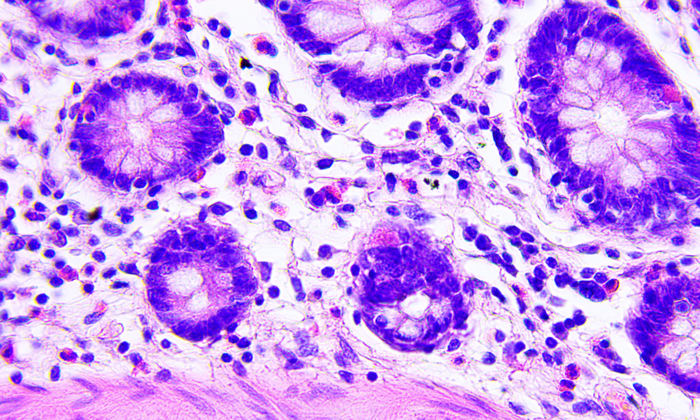Colon cancer: distinct transcriptional programmes identified
Posted: 4 March 2024 | Ellen Capon (Drug Target Review) | No comments yet
Researchers elucidate the significant role of CDX2 in regulating stemness and differentiation, particularly in the proximal colon’s epithelial cells. This research encourages new combinations of existing drugs, that inhibit both the BRAF and KRAS genes, to be explored.


Although it is known that the proximal (right) and distal (left) parts of the colon show different molecular features in cancer, researchers from The Johns Hopkins University School of Medicine have now elucidated that the proximal and distal parts of the colon have different transcriptional programmes too, that regulate the development of normal and malignant cells.
CDX2, the homeobox transcription factor which plays a key role in the development and function of the digestive system, was found to be a crucial mediator of these differences in proximal colon stem cells. This distinction in stem cell regulation may explain the features of colon cancers in the two regions of the colon, and therefore lead to new combinations of existing therapies to improve treatment efficacy.
Gene mutations
Senior study author Dr Hariharan Easwaran, an associate professor of oncology at The Johns Hopkins University School of Medicine, explained that BRAF gene mutations, which are linked to poor prognoses, mainly contribute to cancers in the proximal colon, whereas KRAS gene mutations commonly contribute to cancers in the distal colon and rectal regions.
Also, there are many epigenetic differences between the two regions. The BRAF-driven proximal colon cancers are associated with a very high frequency of DNA methylation in gene regulatory elements like the CpG islands. BRAF-mutations are seen in around 15 percent of primary colorectal cancers, and in four to 10 percent of metastatic trial patients. Furthermore, the BRAF-V600E mutation accounts for up to 90 percent of all BRAF-mutations.1
Compared to other types of cancer such as melanoma, drugs targeting BRAF mutations have not performed well in colon cancers. Dr Easwaran added: “Dissecting this biology is important to understanding the basis for key differences in the molecular genetics and clinical features of these cancers, and in general for understanding why cancers arising within highly similar tissues in the colon may exhibit distinct features.”
Utilisation of organoids
For the study, the team introduced the BRAF-cancer-causing gene into proximal and distal colon organoids derived from two-month-old mice and identified small differences in gene expression between them. However, the loss of CDX2 produced notable differences in regulation of the genes controlling stem cell differentiation.
The scientists saw that CDX2 specifically promotes changes to stem cells and differentiated cell states in the proximal colon, specifically in epithelial cells. However, the loss of CDX2 expression, which is associated with BRAD mutant colon cancers, means that the cells become more stem-cell like. In proximal colon stem cells, the team silenced CDX2, which enabled BRAF mutations to drive tumour initiation in the stem cells. In the distal colon, silencing CDX2 did not bring about much change.
Lead author Dr Liijing Yang, oncologist at The Johns Hopkins University School of Medicine and Zhongnan Hospital of Wuhan University, commented: “There is something very different in how stem cells are regulated in these two regions, and underscores the potential for epigenetic factors in modulating tumour initiation differently in the proximal and distal colon.”
Improving drug efficiency
This research could lead to new combinations of existing drugs to inhibit both the BRAF and KRAS genes. Dr Easwaran stated: “Colon cancers are very notorious in that they develop resistance to these inhibitors…There’s a lot of interest in trying to figure out how else we can actually improve the efficiency of these drugs.”
“Our study shows that the transcriptional states regulating stem cell and differentiation states are important for the cancer driver mutations to drive cancers”
Moving forward, the researchers will aim to determine what central mechanisms are happening in the distal colon that reduces incidence of BRAF-driven tumours and, conversely, generates a greater likelihood for KRAS-driven cancers.
Dr Easwaran concluded: “Our study shows that the transcriptional states regulating stem cell and differentiation states are important for the cancer driver mutations to drive cancers…It also helps explain why tumours arising in different anatomical locations may rely on different cancer-driving mutations. Therefore, determining the mechanisms will help identify novel ways of targeting critical dependencies for these oncogenic mutations.”
This study was published in Nature Communications.
References
1 Algars A, Glimelius B, Heerva E, et al. Atypical (non-V600E) BRAF mutations in metastatic colorectal cancer in population and real-world cohorts. International Journal of Cancer. 2023 September 19 [2024 February 28]; 154(3):488-503. Available from: https://onlinelibrary.wiley.com/doi/full/10.1002/ijc.34733
Related topics
Cancer research, Drug Repurposing, Organoids, Stem Cells
Related conditions
Cancer Research, Colon cancer
Related organisations
the Johns Hopkins University School of Medicine, Zhongnan Hospital of Wuhan University








